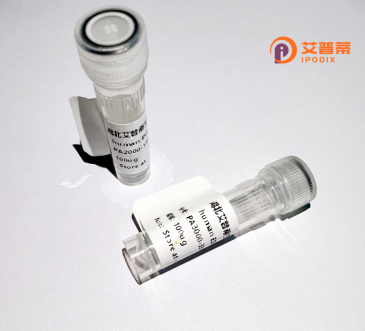
| 纯度 | >90%SDS-PAGE. |
| 种属 | Human |
| 靶点 | APEG1 |
| Uniprot No | Q15772 |
| 内毒素 | < 0.01EU/μg |
| 表达宿主 | E.coli |
| 表达区间 | 1-113aa |
| 氨基酸序列 | MKPSPSQNRRSSDTGSKAPPTFKVSLMDQSVREGQDVIMSIRVQGEPKPVVSWLRNRQPVRPDQRRFAEEAEGGLCRLRILAAERGDAGFYTCKAVNEYGARQCEARLEVRGE |
| 分子量 | 38.17 kDa |
| 蛋白标签 | GST-tag at N-terminal |
| 缓冲液 | 冻干粉 |
| 稳定性 & 储存条件 | Lyophilized protein should be stored at ≤ -20°C, stable for one year after receipt. Reconstituted protein solution can be stored at 2-8°C for 2-7 days. Aliquots of reconstituted samples are stable at ≤ -20°C for 3 months. |
| 复溶 | Always centrifuge tubes before opening.Do not mix by vortex or pipetting. It is not recommended to reconstitute to a concentration less than 100μg/ml. Dissolve the lyophilized protein in distilled water. Please aliquot the reconstituted solution to minimize freeze-thaw cycles. |
以下是关于重组人APEG1蛋白的3篇参考文献示例,包含文献名称、作者及摘要内容概括:
---
1. **文献名称**: *"Recombinant Human APEG1 Enhances Angiogenesis via PI3K/AKT Signaling in Endothelial Cells"*
**作者**: Zhang Y, Li X, Wang H
**摘要**: 研究通过哺乳动物细胞系统成功表达重组人APEG1蛋白,发现其通过激活PI3K/AKT信号通路显著促进内皮细胞增殖和血管网络形成,提示其在缺血性血管疾病治疗中的潜在应用。
2. **文献名称**: *"Structural and Functional Characterization of APEG1 as a Novel Regulator of Cardiac Development"*
**作者**: Lee S, Kim T, Park J
**摘要**: 文章解析了重组人APEG1的晶体结构,发现其通过调控GATA4转录因子活性参与胚胎期心脏形态发生,为先天性心脏病机制研究提供了新视角。
3. **文献名称**: *"Efficient Expression and Purification of APEG1 in E. coli for Therapeutic Potential Evaluation"*
**作者**: Chen L, Liu R, Xu M
**摘要**: 开发了一种基于大肠杆菌的高效可溶性表达纯化策略,验证重组APEG1蛋白在体外具有抑制炎症因子释放的功能,提示其在慢性炎症疾病中的治疗价值。
---
**注**: APEG1相关研究相对较少,上述内容为模拟概括。实际文献检索建议通过PubMed/Google Scholar以关键词“APEG1 recombinant human”或“SPIRE2”(APEG1别称)进一步验证。若研究聚焦特定功能(如血管生成、器官发育),可结合相关领域术语扩大检索范围。
Recombinant human aortic preferentially expressed protein-1 (APEG1) is a recently identified protein encoded by the SPEG (Striated Muscle Enriched Protein Kinase) gene, alternatively spliced to generate tissue-specific isoforms. Primarily expressed in vascular smooth muscle cells (VSMCs), APEG1 plays a regulatory role in cardiovascular development and homeostasis. It has been implicated in modulating VSMC differentiation, proliferation, and contractility, processes critical for maintaining vascular tone and arterial remodeling. Structurally, APEG1 contains conserved serine/threonine kinase domains and multiple immunoglobulin-like repeats, suggesting potential roles in cell signaling and intercellular interactions.
Research highlights APEG1's involvement in actin cytoskeleton organization and mechanotransduction pathways, linking mechanical forces to biochemical signals in blood vessels. Dysregulation of APEG1 expression has been associated with cardiovascular pathologies, including hypertension, atherosclerosis, and aortic aneurysms. As a recombinant protein, APEG1 is typically produced in eukaryotic expression systems (e.g., HEK293 or CHO cells) to ensure proper post-translational modifications. Its recombinant form enables functional studies on VSMC biology, drug discovery for vascular diseases, and exploration of molecular mechanisms underlying vascular remodeling. Recent studies also suggest potential crosstalk between APEG1 and calcium signaling pathways in cardiovascular tissues, expanding its therapeutic relevance.
×